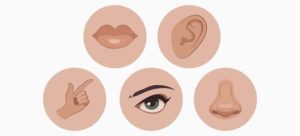Interesting facts about the sensory organs of man
 Information on the world around us is obtained from the many channels that our senses provide. Sight, hearing, smell, touch, taste … It is the combination of all these information channels and provides us with the most complete picture of the world.
Information on the world around us is obtained from the many channels that our senses provide. Sight, hearing, smell, touch, taste … It is the combination of all these information channels and provides us with the most complete picture of the world.
People receive information about the surrounding space with the help of six senses: the ears, eyes, skin, tongue, nose and vestibular apparatus. The data received by each of them enters the nervous system.
More than half of the inhabitants of the Earth have diseases associated with the organs of vision.
There is an opinion that overeating negatively affects hearing.
People feel the taste of solid food only after its interaction with saliva.
Women distinguish shades of smells better than men. In addition, the beautiful half of humanity hears much better than their defenders.
Approximately 2% of the world’s population lacks sense of smell.
Human memory is able to store memories of about 50 thousand fragrances.
Strong noise provokes the dilatation of the pupils.
Everyone has his own, unique smell – focusing on it, babies unmistakably define their mother, and adults can find a suitable partner for them.
The scent of dogs is almost a million times stronger than that of humans.
Ears are not only the organ of hearing, but also an important element of the vestibular system – simply, they help the person maintain balance.
Favorable for human hearing is the noise level of 45-50 decibels – at this volume, quiet conversations are conducted. Any sounds above this limit adversely affect the human body, including the immune system.
The popular opinion about the benefits of carrots for eyesight does not quite correspond to reality – orange fruits do contain a lot of vitamin A, beneficial for the eyes, but eating carrots and excellent eyesight are not directly interrelated.
Most children are born with gray-blue eyes, which only after 2 years acquire their true shade.
The most rare color of the eyes in humans is green (green-eyed are only 2% of the inhabitants of the Earth).
All blue-eyed people came from one ancestor, in the body of which about 6,000 years ago a mutated gene appeared.
Approximately 1% of people have a different color of the iris of each eye.
The eyes of people can distinguish up to 10 million color variations.
Perfect for a person are the spirits, the smell of which he does not feel.
The iris of the eye in each person is no less unique than the fingerprints or the shape of the auricles.
The human brain needs time to process signals from the senses, therefore everything that people feel at a certain moment actually refers to the previous moment of their life. Delay of perception is about 100 milliseconds, but the brain somehow manages to compensate for it – the essence of this mechanism to scientists is not yet clear.
Signals from different senses enter the brain at different speeds, so that later the brain creates a single picture from them.
Scary events are sometimes perceived by people as a film with slow-motion shooting, although in reality frightening phenomena are simply more accurately recorded by the brain.
People who are blind from birth and only become conscious at a conscious age can perceive many things with distortion – since their brains do not know how to dispose of unusual information for him, former blind people see people moving away from them as diminishing in size figures.
If any time passes in glasses, turning the space upside down, the brain adapts to this image. When a person takes off his glasses, the world will appear to him upside down for a while.


























